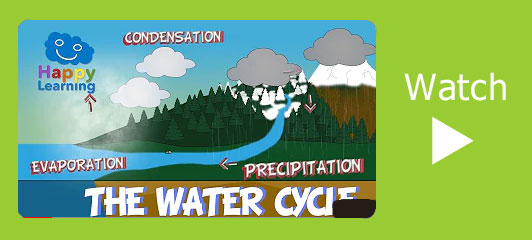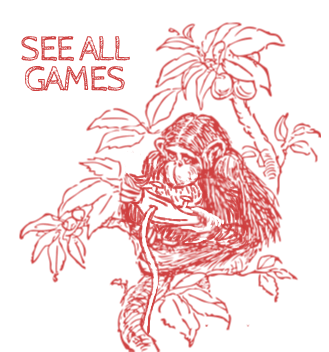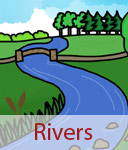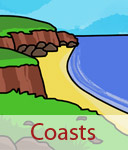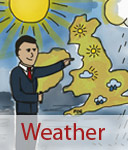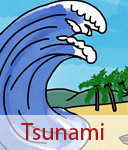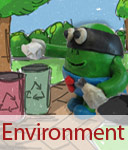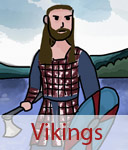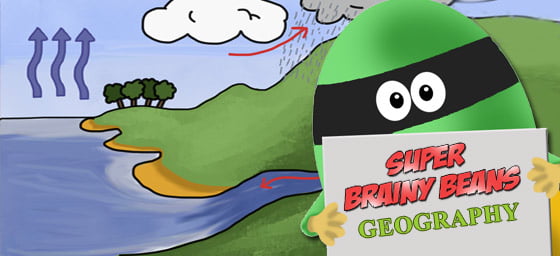
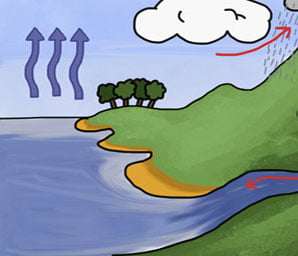
Water Cycle
Water Cycle for kids learning at Primary School. Key Stage 1 & Key Stage 2 (KS1 & KS2) Primary homework help on water and the water cycle.
What is the water cycle?
There is always the same amount of water on the Earth. The water just moves around all the time. This is called The Water Cycle. The water is either in seas and rivers or as ice and snow. It can also be an invisible gas as it evaporates and turns into clouds. It's like a big circle that keeps repeating.
How does the water cycle work?
- It all starts with evaporation. The sun shines on water, like in rivers, lakes, and oceans. When it gets hot, some of the water turns into invisible water vapor. It goes up into the sky from a liquid to a gas.
- As the water vapor goes higher in the sky, it gets colder. Then, it changes back into liquid in the form of tiny water droplets. These droplets come together and form clouds. This is called condensation.
- The wind blows the clouds around. As they move around they collide with other clouds and make bigger clouds. Water stays here for an average of nine days.
- When the clouds get really full of water, the droplets get bigger and heavier. This causes precipitation, when they fall from the clouds as rain, snow, sleet, or hail.
- Collection is when the water that falls on the ground collects in different places. Some of it goes into rivers and flows back into the oceans. Some of it soaks into the ground and becomes groundwater. Some of it stays in lakes and ponds. We can use this water for drinking, bathing, and to help plants grow. From the rivers, lakes and oceans the water cycle starts all over again.
 Weather Wizkids
Weather WizkidsUnderstand how the water cycle works with our facts that help explain the different processes in a way that is easy to follow.
Types of precipitation
Precipitation is the name for water that falls to the earth's surface. Precipitation mainly comes in the form of rain but it can also appear as snow or hail.
Because we have a lot of rain in the UK we have many names to describe the type of rain. For example, we might say it's a: drizzle, downpour, tipping down, shower, sprinkle, sheets of rain or it's raining cats and dogs. Can you think of any more?
Why does it snow?
The air up in the sky is made up of tiny, tiny water droplets called water vapor. When it's really cold, these water droplets freeze and become tiny ice crystals.
When there's a lot of cold air up in the sky, the tiny ice crystals start sticking together. They come together and form snowflakes. Snowflakes are beautiful and unique because each one has its own special shape and pattern. When the snowflakes become too heavy for the air to hold them up, they start falling from the sky. And that's when it starts to snow! The water can also fall as hard balls of ice called hail.
Types of clouds
There are many types of clouds that come in different shapes and sizes. These are some of the common ones that you can see in the sky.
- Cumulus Clouds - Cumulus clouds are big and puffy, like cotton balls. These clouds usually mean nice weather, but they can grow into big thunderstorm clouds called Cumulonimbus Clouds.
- Stratus Clouds - Stratus clouds are low, grey clouds that cover the sky like a blanket. They can make the sky look dull and can bring light rain or drizzle.
- Cirrus Clouds - Cirrus clouds are high up in the sky and look very thin and wispy. They are like delicate feathers or streaks of white paint. Cirrus clouds are a sign that the weather might change soon, and they can sometimes mean that rain or snow is on the way.
- Cumulonimbus Clouds - Cumulonimbus clouds are very tall and powerful clouds. They can reach way up into the sky and look like big towers. These clouds bring thunderstorms with heavy rain, lightning, and sometimes even hail.
- Altostratus Clouds - Altostratus clouds are gray or blue-gray and cover the sky like a thin sheet. They are higher up than stratus clouds but not as high as cirrus clouds. They often mean that rain or snow might come later in the day.
Other cloud types are Nimbostratus, Stratocumulus, Altocumulus, Cirrostratus, Cirrocumulus, Contrails and Fog.
How to make your own cloud
On a very cold day try breathing out. Do you see your breath? This is because your breath has small droplets of water. When you breathe out you can see your breath like a cloud.

